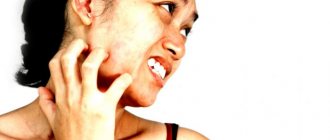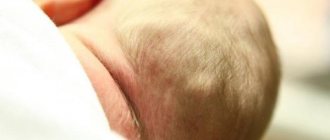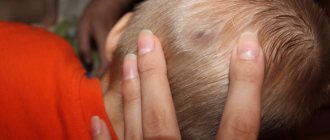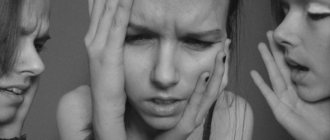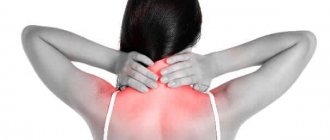How to deal with the feeling of goosebumps in your head?
When you feel goosebumps on your scalp, a shiver runs through your entire body.
There is no headache or other unpleasant sensations. The discomfort that arises does not last long and disappears. You should understand that goosebumps do not appear without a reason. The feeling of insects appears due to functional problems in the body or due to a serious illness. The external manifestations of the symptom look like small bulges on the surface of the skin. Another name is goose bumps. The nerve endings are excited, and the person experiences the sensation of goosebumps.
First aid
If your head is numb not because of a disease, but only because of an external factor, then getting rid of these sensations will not be difficult. You just need to change your position and calm down.
If the provoking factor is cold, you should dress warmly, and you can also apply an alcohol compress. But just don't overdo it. If the sensitivity of the skin is reduced, careless actions can cause a burn. The first aid is to try to improve blood circulation . This must be done both at the location of the numbness and in an attempt to improve blood circulation throughout the body.
- It is necessary to massage the entire scalp, especially the area with reduced sensitivity.
- Drink hot tea with ginger.
- Take a comfortable, relaxed position.
- Calm down and relieve anxiety with the help of calm music, good thoughts, meditation.
Harmless manifestations
Excitation of nerve endings is provoked by an emotional state, reactions to external factors:
- Strong emotional arousal. Fear and stress can send chills down your spine.
- Increased sensitivity of human skin. Touching leads to a reaction to the action.
- Air temperature. A blow of cold wind causes an immediate reaction in the body. To conserve heat, blood vessels constrict and blood flow is directed to maintain heat in vital internal organs. As a result, bumps appear on the skin and a feeling of goosebumps occurs.
- Bad feeling. Sharp and acute pain in the body, high fever.
Excitation of the nervous system, in addition to the tubercles, causes a reaction in the smooth muscles of the skin, causing the hairs to rise.
Diseases
If you feel goosebumps in your head that do not go away for a long time, you should consult a specialist! A neuropathologist will conduct the necessary examination, give directions for tests and be able to make a diagnosis and prescribe adequate treatment.
Follicular hyperkeratosis
This is a disease characterized by the appearance of a dense layer on the scalp - keratinization. Hair follicles are covered with scales, the fat released from the sebaceous glands glues them together. As a result, an inflammatory process occurs under the keratinization and a crawling sensation is felt.
The reasons that cause the appearance of keratinization are associated with external factors:
- Daily use of hair washes;
- Eating disorder;
- Uncontrolled use of hormonal drugs.
Follicular hyperkeratosis can be treated at home with medications prescribed by your doctor.
Avitaminosis
Vitamin deficiency leads to many unpleasant symptoms. The lack of vitamins B1, C and vitamin D in the body leads to deterioration of the scalp. Additionally, the following symptoms appear: peeling of the skin, irritation, and muscle weakness.
The feeling of frost on the skin associated with vitamin deficiency requires replenishing the deficiency with special medications or balancing the diet. The diet should include the following ingredients: seafood, nuts, herbs, wholemeal flour products, orange fruits and vegetables.
Hypoparathyroidism
Dysfunction of the parathyroid glands leads to the development of a disease - hypoparathyroidism. The mineral balance in the body is disturbed. The potassium content decreases and the amount of phosphorus increases. The muscles contract spontaneously, and numbness of the limbs is felt.
The disease occurs when there are problems with the thyroid gland or injuries:
- Performing surgery on the throat organs. Damage to the parathyroid glands occurs when the main gland is completely removed or an oncological tumor occurs.
- If the neck is injured, internal hemorrhage may occur.
- Inflammation of organs.
- The appearance of metastases in the parathyroid glands.
- Radiation exposure.
- Disruption of the endocrine system.
The disease can manifest itself as functional hearing disorders.
Increased sensitivity of the skin
With a cold, the patient may feel goosebumps running all over his head. The problem is associated with increased skin sensitivity. High fever and pain in the head can cause discomfort throughout the body.
Vascular and heart diseases
The feeling of goose bumps in the head on the right side may be associated with ailments of the cardiovascular system:
- An increase in the amount of lipids in the bloodstream. By settling on the walls of blood vessels, they lead to a decrease in the capacity of the arteries, causing an increase in pressure.
- Benign and malignant tumors can put pressure on blood vessels, limiting blood flow.
- The presence of arterial hypertension in the body. A disease associated with persistently high blood pressure.
- Atherosclerotic plaques. Accumulations of cholesterol and lipid proteins form on the walls of blood vessels. The lumen of the arteries narrows, blood flow decreases. Over time, the plaques absorb calcium, which causes more damage to the arteries, even to the point of complete blockage.
- Damage to the internal walls of blood vessels.
These injuries lead to disruption of blood flow. The patient develops hypertension and other symptoms appear:
- Feeling of goosebumps;
- Nausea;
- Paleness of the skin;
- Development of pre-stroke condition.
Bell's palsy
A disease associated with an inflammatory process in the facial nerve. You can feel goosebumps crawling on one side of your face. Then the muscles relax, and over time, motor activity completely stops. The disease appears unexpectedly, without preliminary symptomatic manifestations.
Osteochondrosis
Pathological disorders in the intervertebral discs of the cervical spine. Nerve endings and blood vessels are pinched by discs located near each cervical vertebra. The patient feels:
- Numbness of the skin;
- Headache;
- Pain in the neck muscles with tingling.
Cervical plexus neuropathy
Damaged nerves of the cervical spine indicate the development of a disease - cervical plexus neuropathy. The appearance of goose bumps is observed in the back of the head, ears, and neck. Pain appears.
Atherosclerosis
Violation of lipid metabolism leads to the deposition of cholesterol and fats on the internal parts of blood arteries and vessels. The blood flow is disrupted, which leads to pale skin and goosebumps. Trophic ulcerative lesions appear on the vessels.
The appearance of internal blockages in blood vessels occurs due to poor nutrition, alcohol abuse and daily smoking. To prevent the appearance of plaques, it is necessary to change your lifestyle and normalize your diet.
Greater occipital nerve neuropathy
The disease occurs when the occipital nerve is pinched by nearby tissues. Manifested by the following symptoms:
- Goosebumps on the back of the head;
- Feeling of tingling needles in the skin on the head;
- Sensitivity in the hair area decreases.
Microstroke
The blood vessel narrows, causing a disruption in the nutrition of brain cells. The patient feels a tingling sensation for a short time, after 2 hours the sensation will quickly pass.
In case of a micro-stroke, it is necessary to consult a neurologist. He will prescribe treatment for the head to prevent severe intracranial hemorrhages.
The feeling of running insects, pain, numbness and other symptoms that appear regularly require attention and adequate treatment. Often goosebumps occur due to increased sensitivity and irritability of a person.
The absence of external irritation factors returns the central nervous system to normal and sensations disappear. This is considered normal and no medical attention is required.
A person with hypersensitivity, who reacts to everything like a child, is prescribed sedatives and sedatives - glycine, motherwort tincture.
The body's reaction to too strong emotions can be unpredictable. It is necessary to monitor blood pressure; if it increases, it should be brought down with available medications.
The periodic appearance of goosebumps, numbness, pain, tingling indicates a disease. Only a doctor can suggest ways to deal with symptoms. It is possible to prescribe only massage to eliminate pinching. For thyroid diseases and internal injuries, massage is contraindicated.
Self-diagnosis and treatment leads to a worsening of the situation and the appearance of unwanted complications.
Treatment
Treatment options depend on what is causing the problem. If the doctor has made a diagnosis, then you should take a course of the medications that he prescribes. Only getting rid of the root cause will allow you to forget about unpleasant symptoms forever. The treatment itself includes two methods of influencing the body: medicinal and folk. They can be used simultaneously if there are no contraindications.
Drug treatment
Only the attending physician can prescribe medications. It is highly not recommended to purchase and take medications on your own, because... This can cause irreparable harm to your health.
Your doctor may prescribe the following types of medications:
- Sedatives (Glycine, Motherwort, Valerian). Calms the nervous system.
- Antihypoxants (Mexidol, Preductal). Reduce the risk of developing hypoxia.
- Vasodilators (Cavinton, Nicergoline). Improves blood circulation.
- Angioprotectors (Ginkgo-Biloba, Ascorutin). Tones the veins and blood vessels in the head.
- Preparations with vitamin B (Thiamin, Pyridoxine). Improves the quality of nerve tissue.
You can only take mild sedatives (Valerian, Glycine) and painkillers (Nurofen, Paracetamol) on your own.
However, it is important to consider the dosage, and also try to see a doctor as soon as possible
You can also be treated with non-drug means. Some patients are prescribed massage, magnetotherapy, peloid therapy, therapeutic exercises, and electric shock. Also, to increase effectiveness, you may need to adhere to a daily routine, quality sleep and a light diet.
Traditional methods
You can cope with goosebumps at home using traditional methods. They will improve the general condition of the body, after which all unpleasant symptoms will disappear. To do this you will need to use the following recipes:
- Parsley root, flax seeds, pumpkin leg, lilac and chicory flowers, horseradish, dandelion, watermelon rinds - take 2 tbsp. l. and pour 300 ml of boiling water. Let it brew. Take 50 ml every morning and evening.
- Nettle leaves, lingonberries, clover, dill, mint, echinacea - mix all ingredients 2 tbsp. l. and pour 500 ml of boiling water for half an hour. Take 50 ml at night.
It is important to drink the first tincture first, and only then the second. Additionally, you can drink tea with mint or lavender, because
they have a relaxing effect.
Description of the phenomenon
Goosebumps appear when nerve endings in the spinal cord or brain are irritated. The reason is the stimulation of individual nerves, which has such an effect on their endings. The irritation causes muscle contraction, causing a sensation as if the hair on the head has risen, and tiny bugs have begun to run across the skin itself. This phenomenon can affect not only the head, but also any other part of the body where there is at least a little hair.
Goosebumps can be one-time (temporary). In this case, they appear for completely natural reasons in a healthy person. Sometimes they can be combined with seizures, loss of sensation, dizziness, but no medical intervention or medication is required. Goosebumps appear for the following reasons:
- Emotional arousal (joy, surprise, fear);
- Touching sensitive skin;
- Low air temperature, hypothermia;
- High body temperature;
- Poor health (weakness, fatigue, headache).
When such sensations appear under the conditions listed above, there is no need to worry. After some time, the goosebumps will disappear on their own, and not a trace will remain of the unpleasant feelings.
Sometimes goosebumps may appear during sexual arousal. Humans experience this much less frequently than most living beings.
Symptoms and mechanisms of development
The sensation of crawling on the head is associated with the work of blood vessels and impaired venous outflow
Goosebumps are sensations accompanied by a feeling of hair rising and skin irritation. They are formed in response to irritation of the nerve plexuses in the brain or spinal cord.
In response to the reaction, the muscles contract, and it seems as if small insects are running across the skin.
Goosebumps appear mainly on parts of the body with hair.
In pathological conditions, sensations are accompanied by additional symptoms associated with the underlying disease.
Causes associated with pathologies
Goose bumps on the head can be chronic. They are caused by the development of various diseases and are almost always combined with other more serious symptoms. The frequency and regularity of manifestations depend on what particular pathology caused them. In the most dangerous diseases, convulsions, tingling and numbness of the skin appear in damaged areas, sensitivity is lost, temperature is disturbed, and hair falls out.
What diseases can cause goosebumps:
- Osteochondrosis of the cervical spine. Curvature, combined with constant compression of nerve endings, is one of the most common causes of goosebumps. The patient may also feel slight numbness, dizziness, pain in the neck, head and torso, and tingling. If left untreated, symptoms will accompany the person throughout his life.
- Cardiovascular diseases. Most diseases associated with the heart or blood vessels cause many unpleasant symptoms. Patients may have a numb head, they often feel crawling, pain inside the skull, weakness, nausea, their skin becomes paler, their mood and general well-being worsen. Sometimes symptoms can affect the head only on one side, and also “give” to certain parts of the face and arms.
- Micro stroke. If a micro-stroke occurs, the patient’s brain cell nutrition will be disrupted. In this case, the serious symptoms inherent in a regular stroke will be absent. Everything is limited to goosebumps that appear for a short time, painful sensations inside the head, weakness, and dizziness. A microstroke is also called a transient ischemic attack.
- Hypoparathyroidism. The disease is combined with functional disorders of the parathyroid glands, which cause goose bumps on the scalp, very strong nervous excitability, and numbness in the limbs. If left untreated, complications may develop that cause increased symptoms.
- Atherosclerosis. Vascular damage that occurs with this disease can cause chronic goosebumps, pale skin, memory loss, and the formation of small ulcers. There are frequent cases of complications of the disease in the form of acute vascular insufficiency of the brain, which can lead to death.
- Cervical plexus neuropathy. A pinched nerve often occurs against the background of severe curvature of the spine, but this is not a prerequisite for such a phenomenon. If this happens, the person will feel like there are goosebumps running all over the head, and there will also be severe pain radiating to the back of the head, neck, shoulders and the bone behind the ear.
- Neuropathy of the greater occipital nerve. With this disease, damage occurs to the nerve in the back of the head. The patient's skin will become numb and the sensitivity at the back of the head will decrease. Sometimes he may feel tingling in certain areas of the skull.
- Bell's palsy. This name refers to inflammation of the facial nerve, in which goose bumps begin to run on one side of the face, affecting the upper part of the head. Along with this sensation, weakening of the muscles in certain parts of the face may occur. In some cases, the muscles stop working completely, which requires serious medical supervision.
- Avitaminosis. A lack of vitamins leads to a deterioration in the health of the skin, due to which it begins to peel, crack, and a person experiences a burning sensation, itching, is faced with decreased immunity, pain in the back and head, weakness throughout the body, and bad mood.
- Hypoxic conditions. Lack of oxygen occurs when you spend a long time in a stuffy room, as well as when there are disorders in the brain. In both cases, the person will have a crawling sensation in the head, as well as severe pain affecting one temple, the back of the head, the forehead, or one side of the brain. Often the cause of mild hypoxia is vegetative-vascular disorders, as well as a sympatho-adrenaline crisis against the background of VSD, which causes vasoconstriction, causing a full range of unpleasant symptoms.
- Nervous and mental disorders. With various deviations in a person’s mental state, sensations may appear as if bugs began to crawl on the head, dizziness, weakness, headaches, and discomfort in the stomach. Also, as a rule, there are also psychological symptoms, expressed by increased nervousness, moral instability, bad mood, lack of interest in life, and excessive aggression towards others. All this can appear even with regular overwork or stress.
- Cold. ARVI, acute respiratory infections or influenza are always combined with weakness, runny nose, nasal congestion, sore throat, cough, and high body temperature. Some people experience crawling sensations all over their head. Sometimes complications develop, for example, sinusitis. It causes the same goosebumps, as well as severe pain in the forehead, bridge of the nose and temples, which intensifies when turning the head. A person in this condition should definitely call an ambulance.
- Climax. During menopause, women face vascular disorders accompanied by unstable blood pressure. For this reason, they may experience crawling sensations, a headache, numbness in their limbs, and a convulsive syndrome. In some cases, menopause is accompanied by digestive problems, which cause constipation, bloating, colic, vomiting, heartburn, belching, and increased gas formation.
The regular occurrence of goose bumps, combined with other serious symptoms, requires a medical examination. This is the only way to be sure of the presence or absence of any diseases. If the symptoms seem particularly dangerous, you should immediately call an ambulance to eliminate all possible risks.
Diagnostics
To ensure proper treatment of the condition, it is necessary to find out not only the causes, but also the accompanying symptoms. Diagnosis can be carried out using various methods, but first you will need to consult a trichologist or dermatologist. After taking a medical history and visually examining the patient, in most cases doctors can make a preliminary diagnosis.
However, to confirm it, instrumental and laboratory research methods will be required. Patients are required to be prescribed OAC to determine the level of:
- glucose;
- lipids;
- hormones;
- microelements.
Neuromyography is a method for diagnosing goosebumps. A urine test will also be prescribed. In some cases, patients should undergo cervical radiography, neuromyography and tomography. Sometimes rheoencephalography, ECG and ultrasound may be required.
Visit doctor
With occasional goosebumps, there is no reason to worry. However, if you suspect the development of other diseases, you should still think about visiting a doctor. Therefore, you need to know what exactly may indicate serious illness. But no less important is the diagnosis itself, which includes several procedures.
When to visit a doctor
Many people choose to turn a blind eye to minor sensations, which is why they face serious complications. It is very important to promptly notice changes in your body and go to the hospital. You should go to the doctor under the following conditions:
- Symptoms are episodic and last for more than an hour.
- Pain in the head, dizziness, and increased blood pressure appear.
- During an attack, problems with vision, speech or hearing occur.
- It becomes difficult to turn your head.
- The skin changes with each attack.
Is there any cause for concern?
Goosebumps that appear only occasionally do not require any attention. Excessive worry will cause many more problems than this symptom. Therefore, you should consult a doctor only in the cases described above, when serious illnesses are suspected.
I'm getting goosebumps right now
I don’t know which doctor to contact, my head is spinning, goosebumps on my head, I feel unwell
You need to see a neurologist.
my dear girls, all my life I went to see a neurologist, I was in the neurosis clinic at the Bekhterev Institute with the same problems. Well, understand, neurologists have an extremely narrow range of treatment, they can’t do it either right or left, the most they will give you is nootropics, so I ask you to do this What did the doctors in Almazov do for me? A neurologist from Almazov simply referred me to my doctor. This is Vvedenskaya hospital number 72 in St. Petersburg, the department of psychosomatics plus cardiology. This department will help you. I have been visiting neurologists and hospitals for 62 years, now I am at Vvedenskaya hospital. every six months for two weeks, you can go to a day hospital, you can go to a hospital, they put me back on my feet, I beg you, don’t spend money on advertisements, don’t buy anything, don’t use the treatment plan for us
When you can’t do without urgent medical help
Emergency medical care is required by patients whose numbness not only does not go away within 2-3 hours after sleep, but is also accompanied by alarming symptoms. Referring patients to specialists to diagnose brain pathologies increases the likelihood of preventing severe complications.
If numbness (with tingling and other unpleasant sensations) recurs with some frequency, the health problem should not be left to chance. Numbness in any part of the head can lead to dizziness or drowsiness. In some cases, this leads to loss of orientation in space, loss of strength and fainting in the office or other crowded place. If this happens, you cannot postpone calling an ambulance and visiting a doctor.
In rare cases, numbness of the head has other unpleasant “companions”, such as disruption of the musculoskeletal system, nausea and vomiting without symptoms of poisoning, drowsiness and general weakness, impaired control of urination and bowel movements. You should not consider these sensations separately; it is possible that there is a serious illness.
Is your head numb? Establishing the reason
A short-term decrease in sensitivity of the upper or lower extremities does not pose a health hazard and only causes discomfort. The situation when the head goes numb requires a professional assessment. Especially if the symptom occurs regularly or persists for a long time. In most cases, the condition in which a person has a headache and numb skin on the face or back of the head is caused by muscle strain. It is observed after sleep, a long stay in one position, or a sharp turn of the head. If everything goes away after 10-15 minutes, there is no reason to panic.
Why does my head go numb?
A specific symptom is often accompanied by tingling of the lips or the entire face. Sometimes it is accompanied by swelling and a burning sensation in the tissues; control over the facial muscles may decrease or be lost. Serious diseases are diagnosed in 20% of cases when the symptom appears.
Numbness of the head or face is one of the signs of the development of a stroke, so you should not ignore it.
The reasons why the head goes numb can be different:
- effect on tissue at low temperatures;
- spinal column and head injuries;
- infections and toxic effects on the central nervous system;
- brain diseases;
- decreased vascular functionality;
- stress;
- consequences of tooth extraction and other dental procedures;
- taking a number of medications;
- being in an uncomfortable position or making sudden movements.
In all situations, numbness appears due to injury or decreased functionality of the pathways that provide sensitivity to the tissues of the head. Depending on what may be causing it, additional symptoms may be observed to help make a diagnosis.
Hypothermia
A feeling of numbness in the head can occur under the influence of low temperatures.
Due to spasm of the walls of blood vessels, blood circulation in the tissues is disrupted, which leads to a decrease in sensitivity in certain areas or throughout the entire area of the skull. Prolonged exposure to a draft causes goosebumps to appear in the back of the head. The condition may be accompanied by shooting pain. Unpleasant symptoms intensify if you press on the problem area. After the area warms up, they disappear without a trace. You will learn what to do if you have a headache from this article.
Goosebumps running through the head: the main reasons for women
Sometimes the problem is not so bad if it is not directly related to health.
In some situations, numbness in the head is considered normal, since overstrained muscles are to blame. Short-term numbness or tingling is usually observed after waking up if the person took uncomfortable positions during sleep.
Being in one position for a long time (for example, sitting at a computer), the muscles experience severe tension and become “numb.” Compression or pinching of the nerve may also occur.
A feeling of numbness in the head and goosebumps are considered normal even with sudden movements of the neck. In such a situation, the blood vessels experience an unexpected spasm.
Each of these moments is accompanied by disruptions in the blood circulation of the brain, which sometimes leads not only to numbness, but also to dizziness. The condition, which is considered normal, lasts for 10-15 minutes. It is enough to wait until the discomfort passes.
Temporary disruptions can be caused by exposure to certain medications. Numbness of the head is often accompanied by taking statins. It is enough to stop taking them, and the symptoms will go away on their own.
Causes of burning in the neck
The reason why the neck burns is most often osteochondrosis, in which the articular parts and discs of the vertebrae are destroyed. If the pathological process affects the nerve roots, then the person may feel a burning sensation in the part of the body whose nerve has been subjected to pressure.
Also, when the joint space between the vertebrae narrows or the discs move out of their place, pinching of blood vessels and nerves occurs. This leads to the patient experiencing pain and discomfort in the spine. In addition to pathologies, the cause of a burning sensation in the neck on the right can be an injury that led to degenerative disorders in the musculoskeletal system.
Neurological and other diseases
There are many reasons why the head goes numb in one part or another, but very often this is a symptom of one of the neurological diseases:
- Often this condition is accompanied by problems of the cervical spine. The most common disease in this area is osteochondrosis, which leads to pinched nerves, which provokes not only discomfort in tactile sensations, but also stiffness in head movements.
- Vascular diseases of the brain and cerebrovascular disease are another diagnosis in which the described symptom is present.
- Such symptoms are also observed with head and spinal injuries. Injuries to the back or cervical region, as well as the head, are accompanied not only by “goosebumps” on the body, but also by severe pain, paralysis and many other symptoms.
- There is also numbness of the scalp and neuroinfections.
- With age, multiple sclerosis develops, the essence of which is the replacement of nervous tissue with connective tissue. This results in numbness of the skin on the head, poor sensitivity of the limbs, and incoordination.
- Tumors of the head or spine, growing, begin to put pressure on neighboring areas, expanding their space. Nerves and blood vessels come under pressure (and displacement), and metastases penetrate the tissue. The processes are accompanied not only by numbness, but also by very severe pain.
The most serious diseases for which numbness is a mandatory symptom relate to the field of oncology. The tumor can be localized in the cervical region or in any part of the brain.
Numbness, goosebumps and tingling are manifestations of sensitivity of the scalp, and the longer such sensations last, the more compelling the reasons that provoke them should be.
The most harmless are colds associated with hypothermia.
Heart disease, hypertension, excess weight lead to disruption of normal blood circulation, which causes vasospasm, resulting in numbness. This condition can be regarded as pre-stroke.
It is impossible to diagnose or eliminate all these factors independently (without the participation of doctors). Therefore, traditional treatment is excluded a priori here.
Treatment methods
Therapy for burning sensation in the left neck, depending on the cause of its occurrence, is carried out using medications and physiotherapeutic procedures. Thus, when the front of the neck burns, doctors recommend the following medications:
- Non-steroidal anti-inflammatory drugs. They help suppress the inflammatory process and slightly relieve pain.
- Chondroprotectors. These medications allow you to restore the cartilage tissue of the vertebrae and prevent their further development.
- Calcium preparations. They are prescribed if a burning sensation in the neck on the right appears against the background of osteoporosis.
- Neurovitamins. These agents activate the restoration of damaged tissues of the nervous system.
- Local medications for inflammation pain. They can be used to treat the neck, but are not allowed to be used on the part of the head where the hair grows.
In most cases, burning in the back of the neck on the right or left can be due to the development of osteochondrosis, then the symptom can be eliminated with the help of medications quite easily.
In addition to drug treatment, doctors recommend manual therapy, acupuncture, massage, and the use of wraps and compresses.
Physiotherapeutic procedures help enhance the therapeutic effects of medications, help prevent the development of exacerbations in chronic spinal diseases, and also contribute to a favorable psycho-emotional state.
Electrophoresis copes well with pain, current treatment helps to relax muscle tissue, magnet therapy suppresses the inflammatory process well and can relieve the patient of a burning sensation in the back of the neck.
You should not self-medicate and delay visiting a doctor. This can aggravate the course of the disease and intensify the symptoms that appear. Even folk remedies must be agreed upon with the attending physician.
Features of symptoms in women
When numbness of the head does not belong to the category of normal, then we are talking about the clinic, the etiology of which can only be determined by a doctor.
Having assessed the nature of the symptoms, the location of the sensations, taking into account the presence of specific diseases, as well as carrying out the appropriate diagnostics, the specialist will render his verdict.
Numbness of the head can be complete, but sometimes only a specific part of it is affected, which indicates dysfunction of certain organs. The nervous system most often affected is:
- If the left or right side of the head goes numb, then the culprit may be vessels in which blood circulation is impaired, or pinched nerves. But sometimes the cause is brain pathologies and cerebral tumors.
- If the back of the head goes numb, then usually the cause is cervical osteochondrosis or other disorders of the cervical region.
- Numbness and tingling in the front of the head is caused by inflammation of the trigeminal nerve. A sign of this is pain radiating to the jaw, ear and eye.
- The frontal part is affected by increased intracranial pressure.
A problem localized to only one side of the head indicates a pathology of the cerebral structure. In this case, the focus is concentrated in the opposite area of the skull.
If goosebumps appear on the head in women, the reason may lie in the hormonal changes in the body that occur during menopause. Symptoms of paresthesia can occur at any stage of the menopause, but they are more pronounced in the premenopausal and menopausal phases, when hormonal surges are most active.
Provoking factors that cause sensitivity disorders in women include vitamin deficiency. The feeling of goosebumps occurs when there is a lack of elements such as:
- vitamins A, D, E, C and B vitamins (cyanocobalamin, folic acid);
- trace elements zinc, copper, iodine.
If the content of useful substances in the body is low, especially during pregnancy, dry skin, dizziness, general weakness and sensitivity disorders of the skin may occur.
The appearance of a crawling sensation on the scalp is observed if the conduction of impulses along the nerves is disrupted. This happens when nerve endings are irritated. If the small subcutaneous muscles that attach to the hair follicles contract, the person feels like goosebumps are running over the head. This unpleasant condition is called paresthesia. The condition occurs with goose bumps.
The appearance of goosebumps on the back of the head or in other parts of the head can be caused by various sensations:
- satisfaction;
- fear;
- excitement;
- admiration;
- delight;
- pleasure.
The appearance of paresthesia is observed when exposed to environmental factors or when certain diseases occur.
Disease Prevention
Any disease, and osteochondrosis is no exception, is easier to prevent than to treat for a long time. If your ears are blocked or there are unpleasant sensations in the neck, face, or head, then you should not put off visiting a doctor. These seemingly unrelated symptoms may indicate the progression of osteochondrosis.
Prevention of cervical osteochondrosis is an opportunity to avoid many unpleasant and often painful symptoms.
As a preventative measure, it is imperative to lead an active lifestyle, not subject the body to strong physical stress, avoid hypothermia of internal organs, and try not to lift heavy loads. In addition, you need to regularly engage in therapeutic exercises and devote a few minutes to gymnastics during long periods of work at the computer.
Every person should remember that only timely consultation with a doctor will avoid health problems in the future. Preventive measures are also important to help prevent the development of pathologies of the musculoskeletal system.
Diagnostic measures
A multifaceted examination of the patient’s condition will help the doctor determine the location of the source of the problem and its cause. In addition to visual diagnosis and analysis, a differential study is added, which allows one to completely determine the cause and extent of the lesion.
Set of research procedures:
- they begin with a general blood test to identify a lack of vitamin B12 in the body and the presence of iron deficiency anemia;
- instrumental studies such as radiography and spiral computed tomography will make it possible to assess the condition of the brain, skull, spine and identify pathologies if they are present;
- Electroneuromyography will help find the damaged nerve;
- Doppler ultrasound makes it possible to assess the condition of blood vessels and help diagnose diseases of the cardiovascular system;
If after these studies and tests the picture remains not completely clear, the doctor will prescribe additional procedures based on the patient’s condition.
First aid
When there is short-term numbness of the head, which is normal, you can relieve tension with a light massage.
If there is discomfort caused by pathology, this will not work - you must first eliminate the cause (and only a doctor can identify it). You should not look for ways to “help” yourself, so as not to harm yourself even more with self-medication.
The main step that the patient must take is to immediately go to a medical facility. If you cannot do this yourself, you must call an ambulance.
When do you urgently need to see a doctor?
Not everyone perceives periodically occurring long-term numbness and tingling in the head as a reason to see a doctor. But when the following accompanying symptoms occur, it’s time to sound the alarm:
- Tingling and numbness are often accompanied by dizziness and lightheadedness. Here, constant drowsiness, general weakness and unsteadiness of gait are possible.
- Nausea appears, often ending in vomiting. It is difficult for the patient to control the bladder - it is emptied involuntarily.
- Numbness may cause dysfunction of the musculoskeletal system. Problems arise either in individual parts of the body, or complete paralysis occurs.
- Difficulty with movement is reflected in speech, the tongue becomes numb, and it is impossible to understand what the person is saying.
Even one of the factors described is already a serious reason to visit a neurologist or surgeon if it is related to injury.
Treatment approach
Complex treatment is prescribed only after a complete examination of the patient. The doctor prescribes medications individually for each patient, taking into account the reasons that led to numbness of the head.
The first step in therapy will be blocking pain, reducing temperature (if present) and administering drugs that restore circulatory function.
If numbness is a symptom of one of the diseases, then the main goal will be to treat this disease. In some cases, you will have to settle for long-term therapy and no less long-term rehabilitation.
A positive treatment outcome in this situation will depend not only on the doctors, but also on the patient himself, who takes full responsibility for his condition.
The symptoms described above should not be ignored. The sooner the patient goes to a medical facility, the easier and faster the treatment will be. Every day of delay reduces the chances of recovery and provokes serious consequences.
Source: //my-top5.ru/retsepty/murashki-po-shee-szadi/


